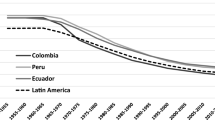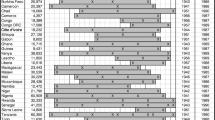Abstract
In many areas throughout sub-Saharan Africa, young adult cohorts are less educated than their predecessors because of declines in school enrollments during the 1980s and 1990s. Because a woman with little education typically becomes a mother earlier and has more children than one with better education, and because of a similar well-established relationship between current education and current fertility at the societal level, one might expect such education reversals to raise fertility. However, if there is an additional negative effect of low educational level among currently young women compared with that in the past, which would accord with ideas about the impact of relative deprivation, the total effect of an education reversal may run in either direction. This possibility has not been explored in earlier studies, which have taken a more static approach. We focus on the initiation of childbearing. Using Demographic and Health Survey data from 16 sub-Saharan African countries with multiple surveys, we estimate a fixed-effects multilevel model for first births that includes the woman’s own education, community education, and community education relative to the past. There are negative effects of individual and community education, but no effect of relative education. Thus we conclude that education reversals do seem to speed up entry into parenthood.
Similar content being viewed by others
References
Axinn, W.G. and J.S. Barber. 2001. “Mass Education and Fertility Limitation.” American Sociological Review 66:481–505.
Becker, G. 1991. A Treatise on the Family. Cambridge, MA: Harvard University Press.
Blossfeld, H.-P. and J. Huinink. 1991. “Human Capital Investments or Norms of Role Transition? How Women’s Schooling and Career Affect the Process of Family Formation.” American Journal of Sociology 97:143–68.
Bongaarts, J. and S.C. Watkins. 1996. “Social Interactions and Contemporary Fertility Transitions.” Population and Development Review 22:639–82.
Brydon, L. and K. Legge. 1996. Adjusting Society: The World Bank, the IMF and Ghana. London: I. B. Tauris Publishers.
Caldwell, J.C. 1980. “Mass Education as a Determinant of the Timing of Fertility Decline.” Population and Development Review 6:225–55.
Castro Martín, T. 1995. “Women’s Education and Fertility: Results From 26 Demographic and Health Surveys.” Studies in Family Planning 26:87–202.
Colclough, C. with K. Lewin. 1993. Educating All the Children: Strategies for Primary Schooling in the South. Oxford: Clarendon Press.
Diez Roux, A.V. 2004. “Commentary: Estimating Neighborhood Health Effects. The Challenges of Causal Inference in a Complex World.” Social Science & Medicine 58:1953–60.
Duflo, E. 2004. “The Medium Run Effects of Educational Expansion: Evidence From a Large School Construction Program in Indonesia.” Journal of Development Economics 74:163–97.
Duryea, S., D. Lam, and D. Levison. 2003. “Effects of Economic Shocks on Children’s Employment and Schooling in Brazil.” PSC Research Report 03-541. Ann Arbor: University of Michigan Population Studies Center.
Easterlin, R.A. 1978. “The Economics and Sociology of Fertility: A Synthesis.” Pp. 57–133 in Historical Studies of Changing Fertility, edited by C. Tilly. Princeton, NJ: Princeton University Press.
Eloundou-Enyegue, P.M. and J. DaVanzo. 2003. “Economic Downturns and Schooling Inequality, Cameroon, 1987–95.” Population Studies 57:183–97.
Eloundou-Enyegue, P.M. and C.S. Stokes. 1999. “Every Family for Themselves? Economic Crisis and the Fostering of School Children in Africa.” Paper presented at the annual meeting of the Population Association of America, New York, March 25–27.
—. 2004. “Teen Fertility and Gender Inequality in Education: A Contextual Hypothesis.” Demographic Research 11:305–34.
Folbre, N. 1988. “Patriarchal Social Formations in Zimbabwe.” Pp. 61–80 in Patriarchy and Class: African Women in the Home and the Workforce, edited by S.B. Stichter and J.L. Parpart. Boulder: Westview Press.
Frankenberg, E. and W. Suriastini. 1999. “Health, Education and the Economic Crisis in Indonesia.” Paper presented at the annual meeting of the Population Association of America, New York, March 25–27.
Goody, J. 1993. “The Future of the Family in Rural Africa.” Pp. 15–63 in Readings in Population Research Methodology, Vol. 4, edited by G.W. Rumsey. Chicago: United Nations Fund for Population Activities.
Grant, M.R. and A.D. Palmiere. 2003. “When Tea is a Luxury: The Economic Impact of HIV/AIDS in Bulawayo, Zimbabwe.” African Studies 62:213–41.
Happel, S.K., J.K. Hill, and S.A. Low. 1984. “An Economic Analysis of the Timing of Childbirth.” Population Studies 38:356–66.
Hirschman, C. and P. Guest. 1990. “Multilevel Models of Fertility Determination in Four Southeast Asian Countries: 1970 and 1980.” Demography 27:369–96.
Jejeebhoy, S.J. 1995. Women’s Education, Autonomy, and Reproductive Behaviour: Experience From Developing Countries. Oxford: Clarendon Press.
Kohler H.-P., J.R. Behrman, and S.C. Watkins. 2001. “The Density of Social Networks and Fertility Decisions: Evidence From South Nyanza District, Kenya.” Demography 38:43–58.
Kravdal, Ø. 2001. “The High Fertility of College Educated Women in Norway: An Artifact of the Separate Modelling of Each Parity Transition.” Demographic Research 5:188–215.
—. 2002a. “Education and Fertility in Sub-Saharan Africa: Individual and Community Effects.” Demography 39:233–50.
—. 2002b. “The Impact of Individual and Aggregate Unemployment on Fertility in Norway.” Demographic Research 6:264–93.
Lam, D. and S. Duryea. 1999. “Effects of Schooling on Fertility, Labor Supply, and Investments in Children, With Evidence From Brazil.” Journal of Human Resources 24:160–92.
Larsen, U.M. and M. Hollos. 2005. “The Importance of Motherhood: A Community Based Study of Infertility in Moshi, Northern Tanzania.” Paper presented at the annual meeting of the Population Association of America, Philadelphia, March 31-April 2.
Lichter, D.T., D.K. McLaughlin, G. Kephart, and D.J. Landry. 1992. “Race and the Retreat From Marriage: A Shortage of Marriageable Men?” American Sociological Review 57:781–99.
Lloyd, C.B., Ed. 2005. Growing Up Global: The Changing Transitions to Adulthood in Developing Countries. Washington, DC: The National Academies Press.
Lloyd, C.B., C.E. Kaufman, and P. Hewett. 2000. “Implications for Fertility Change of the Spread of Primary Schooling in Sub-Saharan Africa.” Population and Development Review 26:483–515.
Macassa, G., G. Ghilagaber, E. Bernhardt, F. Diderichsen, and B. Burström. 2003. “Inequalities in Child Mortality in Mozambique: Differentials by Parental Socio-Economic Position.” Social Science & Medicine 57:2255–64.
Macintyre, S., A. Ellaway, and S. Cummins. 2002. “Place Effects on Health: How Can We Conceptualise, Operationalise and Measure Them?” Social Science & Medicine 55:125–39.
Macunovich, D.J. 1998. “Fertility and the Easterlin Hypothesis: An Assessment of the Literature.” Journal of Population Economics 11:53–111.
Makinwa-Adebusoye, P. 1994. “Changes in the Costs and Benefits of Children to Their Parents.” Pp. 175–192 in The Onset of Fertility Transition in Sub-Saharan Africa, edited by T. Locoh and V. Hertrich. Liège, Belgium: IUSSP.
Manski, C.F. 1993. “Identification of Endogenous Effects: The Reflection Problem.” The Review of Economic Studies 60:531–42.
Mari Bhat, P.N. 1998. “Emerging Regional Differences in Fertility in India: Causes and Correlations.” Pp. 131–68 in Reproductive Change in India and Brazil, edited by G. Martine, M.D. Gupta, and L.C. Chen. New Delhi: Oxford University Press.
Mason, A. 1993. “The Response of Fertility and Mortality to Economic Crisis and Structural Adjustment Policy During the 1980s: A Review.” Pp. 411–29 in Montreal 1993 International Population Conference, Vol. 2. Liège, Belgium: IUSSP.
Mensch, B.S., S. Singh, and J. Casterline. 2005. “Trends in the Timing of First Marriage Among Men and Women in the Developing World.” Working Paper No. 202. Population Research Division, The Population Council, New York.
Montgomery, M.R. and J.B. Casterline. 1996. “Social Learning, Social Influence and New Models of Fertility.” Population and Development Review 22 (Suppl.):151–75.
Nagashima, N. 1987. “Aspects of Change in Bridewealth Among the Iteso of Kenya.” Pp. 183–98 in Transformations of African Marriage, edited by D. Parkin and D. Nyamwaya. Manchester, United Kingdom: Manchester University Press for the International African Institute.
Oakes, J.M. 2004. “The (Mis)estimation of Neighborhood Effects: Causal Inference for a Practicable Social Epidemiology.” Social Science & Medicine 58:1929–52.
Oliver, R. 1995. “Family Size Decisions in Sub-Saharan Africa: An Empirical Analysis for Ghana.” Ph.D. dissertation. Department of Economics, Stanford University.
Raikes, P. and P. Gibbon. 1996. “Tanzania, 1986–94.” Pp. 215–307 in Limits of Adjustment in Africa: The Effects of Economic Liberalization, 1986–94, edited by P. Engberg-Pederson, P. Gibbon, P. Raikes, and L. Udsholt. Oxford: James Currey.
Rindfuss, R.R., S.P. Morgan, and C.G. Swicegood. 1988. First Births in America: Changes in the Timing of Parenthood. Berkeley: University of California Press.
South, S.J. and K.D. Crowder. 2000. “The Declining Significance of Neighborhoods? Marital Transitions in Community Context.” Social Forces 78:1067–99.
Thurow, L.C. 1975. Generating Inequality: Mechanisms of Distribution in the U.S. Economy. New York: Basic Books.
United Nations. 2004. World Population Prospects: The 2004 Revision Population Database. Available online at http://esa.un.org/unpp/index.asp?panel=2
Walker, I. and H.J. Smith, Eds. 2002. Relative Deprivation. Specification, Development, and Integration. Cambridge, England: Cambridge University Press.
Watkins, S., N. Rutenberg, and D. Wilkinson. 1997. “Orderly Theories, Disorderly Women.” Pp. 213–45 in The Continuing Demographic Transition, edited by G.W. Jones, J.C. Caldwell, and R.M. D’Souza. Oxford: Oxford University Press.
Author information
Authors and Affiliations
Additional information
This work was funded in part with a seed grant from the Maryland Population Research Center, with support from the National Institutes of Health and Human Development Grant No. R24 HD41041-04. We thank Parfait Eloundou-Enyegue, Hans-Peter Kohler, two referees, and the editors for their contributions at earlier stages of this work.
Rights and permissions
About this article
Cite this article
Derose, L.F., Kravdal, Ø. Educational reversals and first-birth timing in sub-saharan africa: A dynamic multilevel approach. Demography 44, 59–77 (2007). https://doi.org/10.1353/dem.2007.0001
Issue Date:
DOI: https://doi.org/10.1353/dem.2007.0001




